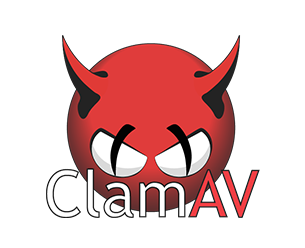Dockerized open source antivirus daemons for use with
- file sharing containers like Nextcloud or
- to use it via a REST proxy like @solita made clamav-rest or
- to directly connect to clamav via TCP port
3310
ClamAV daemon as a Docker image. It builds with a current virus database and
runs freshclam in the background constantly updating the virus signature database. clamd itself
is listening on exposed port 3310.
Find the latest releases at the official docker hub registry. There are different releases for the different platforms.
The container run as user clamav with uid=101 and gid=102.
- buster-slim
- stretch-slim
docker run -d -p 3310:3310 mkodockx/docker-clamav:buster-slim- alpine
- alpine-edge
docker run -d -p 3310:3310 mkodockx/docker-clamav:alpineLinked usage recommended, to not expose the port to "everyone".
docker run -d --name av mkodockx/docker-clamav(:alpine)
docker run -d --link av:av application-with-clamdscan-or-somethingThanks to @mchus proxy configuration is possible.
- HTTPProxyServer: Allows to set a proxy server
- HTTPProxyPort: Allows to set a proxy server port
Specifying a particular mirror for freshclam is also possible.
- DatabaseMirror: Hostname of the mirror web server.
Mount custom configuration files into the container.
- FRESHCLAM_CONF_FILE: Path to custom
freshclam.conffile, e.g./mnt/freshclam.conf. - CLAMD_CONF_FILE: Set the path to a custom
clamd.conffile, e.g./mnt/clamd.conf.
Virus update definitions are stored in /var/lib/clamav. To store the defintion just mount the directory as a volume, docker run -d -p 3310:3310 -v ./clamav:/var/lib/clamav mkodockx/docker-clamav:latest
See example with Nextcloud at docker-compose.yml. You still need to configure the AntiVirus files app in Nextcloud.
You can find a tutorial here: https://www.virtualconfusion.net/clamav-for-nextcloud-on-docker/
The images provide with check.sh a file to check for the healthyness of the running container. To enable the health check configure your docker run or compose file. The start period should be adjusted to your system needs. Slow internet connection, with limited cpu and IO speed might require larger values.
Via docker run:
docker run --health-cmd=./check.sh \
--health-start-period=120s \
--health-interval=60s \
--health-retries=3 \
-p 3310:3310 mkodockx/docker-clamav:alpine`
Via docker-compose
services:
clamav:
healthcheck:
test: ["CMD", "./check.sh"]
interval: 60s
retries: 3
start_period: 120sThis image provides support for different platforms
- x86
- amd64
- arm32v7
- arm64v8
- OpenShift support in kuanfandevops fork
Some users are wondering about memory consumption of clamd. Here is an explanation of the reasons I found:
"ClamAV holds the search strings using the classic string (Boyer Moore) and regular expression (Aho Corasick) algorithms. Being algorithms from the 1970s they are extemely memory efficient.
The problem is the huge number of virus signatures. This leads to the algorithms' datastructures growing quite large.
You can't send those datastructures to swap, as there are no parts of the algorithms' datastructures accessed less often than other parts. If you do force pages of them to swap disk, then they'll be referenced moments later and just swap straight back in. (Technically we say "the random access of the datastructure forces the entire datastructure to be in the process's working set of memory".)
The datastructures are needed if you are scanning from the command line or scanning from a daemon.
You can't use just a portion of the virus signatures, as you don't get to choose which viruses you will be sent, and thus can't tell which signatures you will need." Source stackexchange.com
It is obvious that an antivirus engine based on virus signatures will raise memory consumption over the time as it always has to check for all signatures. As the number of virus signatures grows daily, the amount of necessary memory will increase as well.

